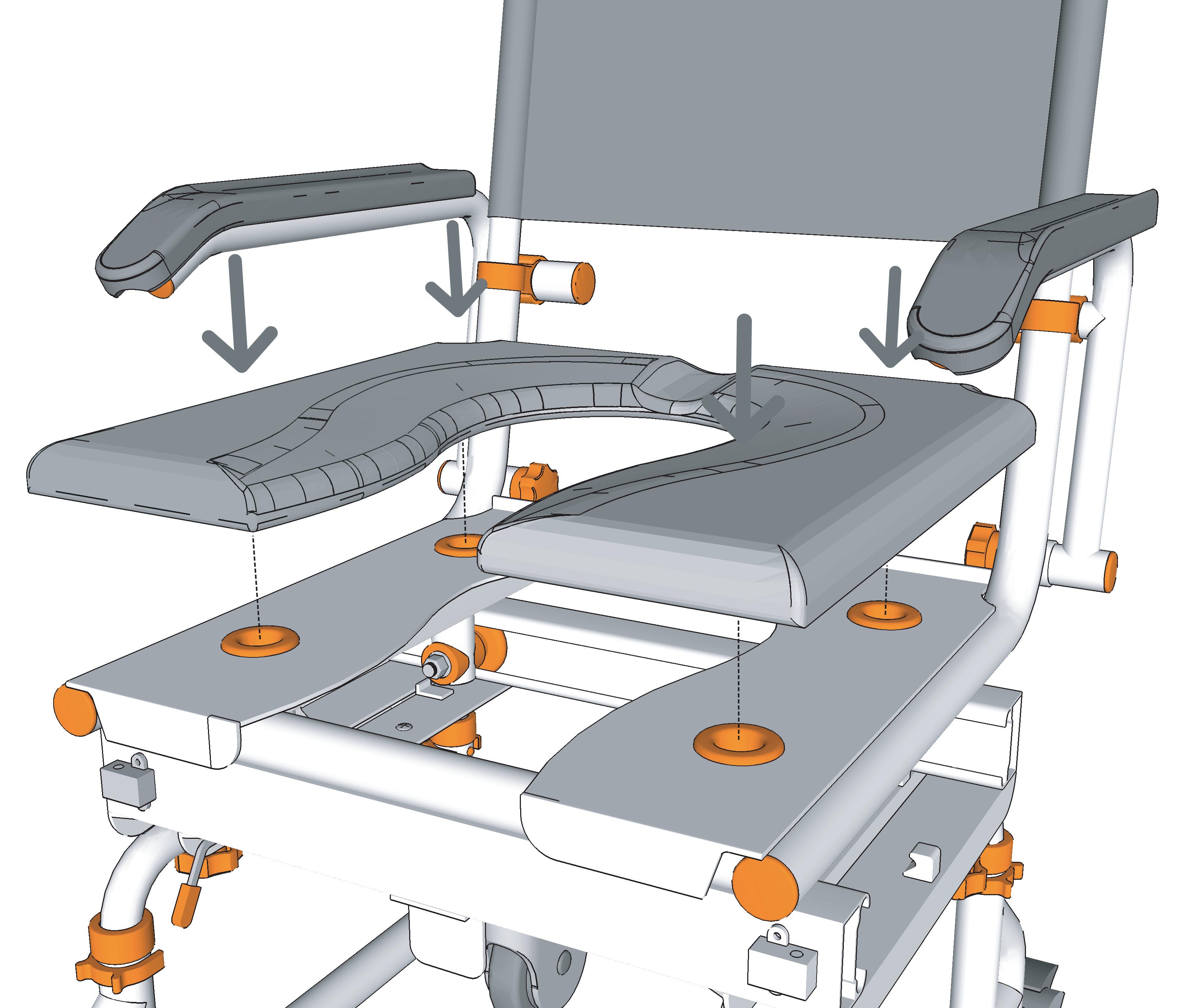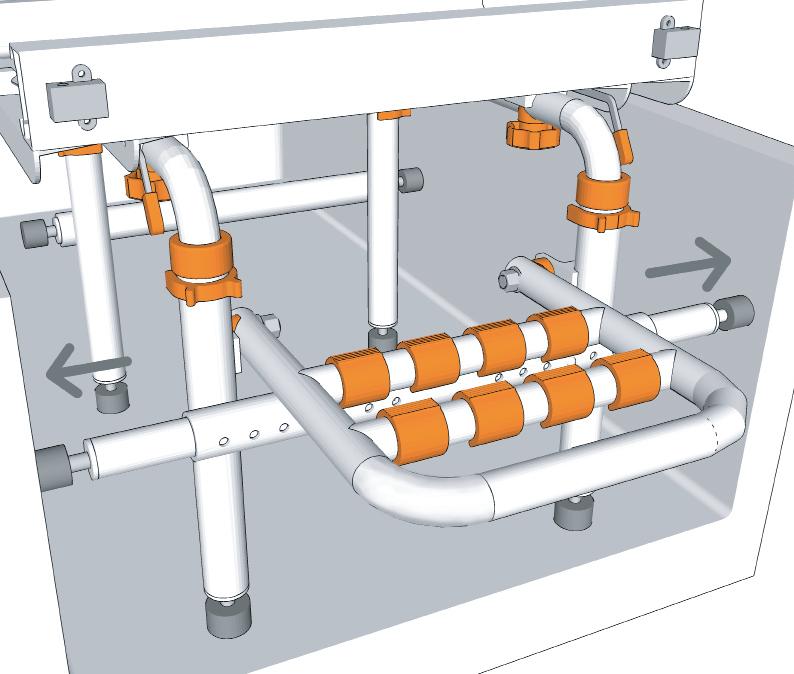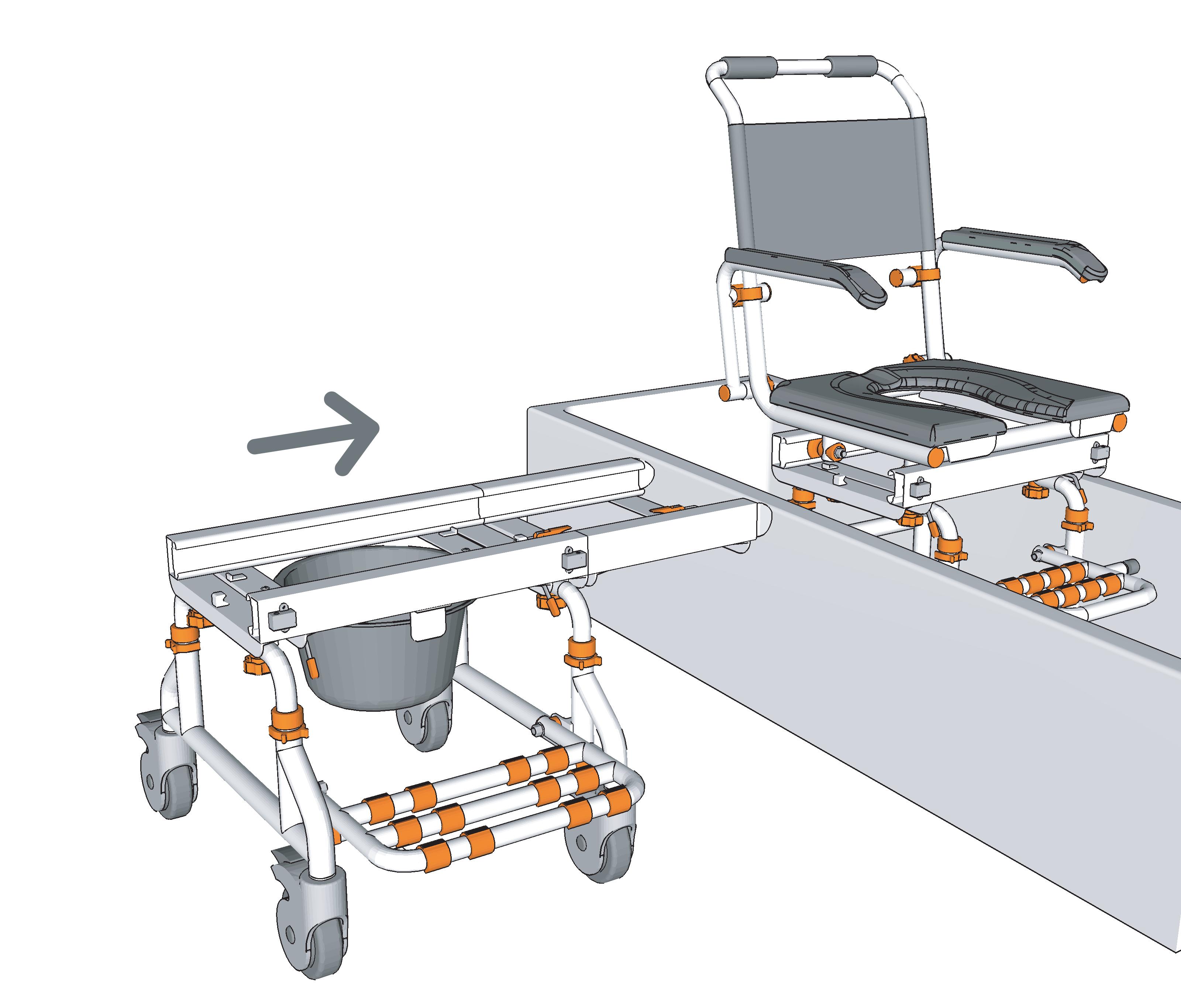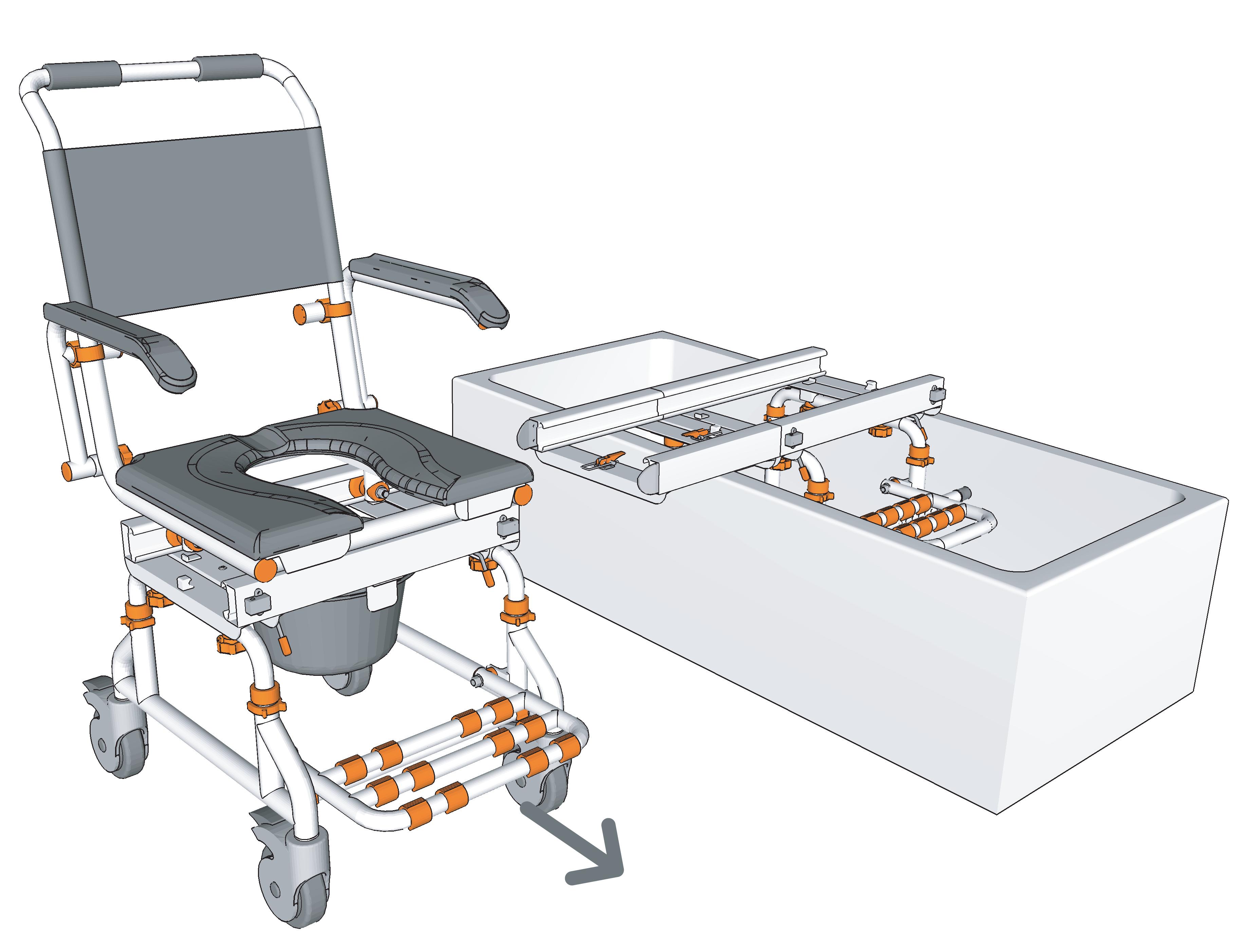






Showerbuddy undertakes continuous improvement to design and function. Some parts may be shown that have subsequently been updated or changed since publication.

See the exploded chair image for the location of parts.
Insert the back rest into the seat base.
Slide the back rest into the seat base until the clip pins click into the holes on the seat base.
The clip pins secure the chair back frame in position.
To remove the seat back press the clip pins in and slide the seat back out of the seat base.
Insert the arm rests into the sockets on the seat base until the clip pin clicks and locates the arm rests in position.



Screw the arm rest knob into the arm rest to firmly secure the arm rest in position.
Swing the arm rest forward so that it locks into position in the arm rest clip.
Slide the arm rest lock over the arm rest clip to lock the arm rest in position.
By sliding the armrest lock you can easily swing the armrest out of the way or secure the armrest in position.
To unlock the armrest slide the armrest lock away from the armrest.
To lock the armrest slide the armrest lock towards the armrest.
The armrest locks should always be used when the armrests aren’t in the swing away position.

The armrests can be easily swung-away when required.
Unlock the armrest by sliding the armrest lock away from the armrest. Once this is done the armrest can be swung away. The clip pin which secures the armrest in position stops the armrest from rotating to far.
NOTE - The armrest locks should always be used when the armrests aren’t in the swingaway position.


Ensuring the correct orientation attach the seat cushion to the seat base by pushing the 4 locating lugs on the underside of the cushion into the connectors on the seat base.
Firmly press the cushion into position so that the 4 locating lugs are securely located in the connectors.

To remove the cushion, carefully remove one lug at a time from the connectors until all 4 locating lugs are removed.
Rotate the chair so that you have easy access to the underside of the seat base.
From the back of the chair slide the commode bucket into the 2 brackets on the underside of the seat base.
Ensure the commode bucket is pushed in far enough that the brackets securely hold the commode bucket in position. The commode bucket should be centred under the opening in the cushion.

Using the grooves on the underside of the bath base track as a guide, place the bath base track onto the height adjustment tubes. They can only be fitted when aligned correctly. Do not remove the bolt that must go into one of the holes in the tube. Once positioned on the bath base track screw up the thumb knobs / screws and plastic half-moon washers.
To attach the chest belt rotate the chair so that you have easy access to the back of the back rest.

Slide the chest belt through the 2 attachment loops on the back rest.Before use adjust the length of the chest belt to suit the user

Align the side of your chair with the threshold of your bath.
Check to ensure that the height of the bottom of the wheeled track is higher than the bath threshold .
If required the height of the wheeled track can be raised or lowered depending on the bath threshold height.

Each height adjustment hole raises the wheeled track 25mm or 1”. This will also determine the lowest seat height.
To adjust the height remove the securing clips and slide the height adjust-ment tubes up or down to the required height.
Secure both height adjustment tubes at the required height using 1 large securing clip on each base leg.
Each height adjustment hole raises the seat base 25mm or 1”.
Check to ensure all securing clips are fully inserted.
Ensure both height adjustment tubes are aligned at the same height.

Place the assembled bath base into your bath.
When positioning the bath base ensure it is located so there is enough room to allow the chair to transfer freely without hitting any other obstructions.

Rubber suction cup feet are required to be fitted to the bath base if the bath tub is plastic or fibreglass
Check to ensure that the height of the bottom of the bath base track is higher than the bath threshold 'B' .
If required the height of the bath base track can be raised or lowered depending on the bath threshold height.

Each height adjustment hole raises the bath base track 25mm or 1”.
Align the bridge with the bath base and insert the tongues into the bath base.
Firmly push the tongues on the bridge into the bath base so the secondary brakes are pushed out of the way.
Secure the bridge to the bath base using the latch in the centre of the bridge track.
Align the side of your chair with the bridge which is connected to the bath base.

Firmly push the wheeled base onto the tongues on the bridge so the secondary brakes are pushed out of the way.
Secure the bridge to the bath base using the latch in the centre of the bridge track.

The wheeled base, bridge and bath base should now be securely connected together using the latches.

Before continuing with the setup it is important to ensure that the tracks are level horizontally.
If the tracks are not level horizontally, adjust the height of the bath base until the tracks are level.

To do this screw the thread on the rubber feet up or down depending on which way the height needs to be adjusted.
Do not unscrew the thread more than 25mm or 1”. If you require more height, raise the bath base track by adjusting the height adjust-ment tubes up or down.
With the bath base placed in the bath secure it in position by adjusting the side stabilising tubes.

Press the clip pin in on the stabilising tube and slide outwards to the correct position. For smaller adjustments unscrew the rubber stopper to firmly secure the bath base.
If you have a wide bath-tub where the side stabilisers do not reach, use suction cup rubber feet on the base.
WARNING
DO NOT STAND ON FOOTRESTS Chair will be unstable and tip forward if body-weight is applied to footrests
Securely attach the bridge to the bath base using the latches. Next securely attach the bridge to the wheeled base using the latches.
Ensure all latches securely ‘snap’ into the locked position. Ensure you lock all castor wheels before beginning the transfer.
Always disconnect the bridge from the base that the chair is located on (bath base or wheeled base).

If you leave the bridge attached it could allow the chair to roll out of the tracks and injure the user. ALWAYS DETACH THE BRIDGE AFTER TRANSFER OF THE CHAIR.

To lock the castor wheels press down firmly on the end of brake with your foot. This will lock the castor so that it will not move or rotate.
To unlock the castor wheels press down firmly on the front of the brake with your foot. This will allow the castor to move freely again.
The castor wheels should always be locked when performing transfers . The castor wheels can be rotated forward to make the chair more stable.
With your Showerbuddy SB2 assembled you are now ready to transfer the chair into the bath.
Lift and hold the primary brake lever to release the chair. The primary brakes are located on each side of the wheeled and bath base tracks at the front.


Once the chair has begun transferring you can release the primary brake. The primary brake will drop back into the correct position.
Transfer your Showerbuddy SB2 from the wheeled base onto the shower base.
Ensure the chair is transferred all the way onto the bath base and primary brake clicks to secure the chair in position.
With your Showerbudd SB2 secured in position on the bath base remove the bridge and wheeled base.
Release the latch which connects the bridge to the bath base and roll the wheeled base and bridge away. If space is limited release the latches on the bridge to remove the bridge from the wheeled base.
NOTE -
Never attach the bridge to the bath base without the wheeled base being attached.
Reconnect the bridge to the wheeled base and secure in position with the latches. Reconnect the bath base to the bridge and secure in position with the latches.


Ensure all latches securely ‘snap’ into the locked position. Ensure you lock all castor wheels before beginning the transfer.
Never attach the bridge to the bath base without the wheeled base being attached.
To transfer your ShowerbuddySB2back to the wheeled base lift and hold the primary brake lever to release the chair. The The primary brakes are located on each side of the wheeled and bath base tracks at the front.


Once the chair has begun transferring you can release the primary brake. The primary brake will drop back into the correct position.
Transfer your ShowerbuddySB2 from the bath base onto the wheeled base.
Ensure the chair is transferred all the way onto the wheeled base and primary brake clicks to secure the chair in position.
Ensure all latches securely ‘snap’ into the locked position.
Ensure you lock all castor wheels before beginning the transfer.
Ensure the primary brake securely locks your Showerbuddy SB2 in position on the wheeled base before disconnecting the bridge.
Unlock the brakes on the castor wheels. Release the latches which connect the bridge to the wheeled base and roll the wheeled base away.

It is recommended that your shower chair is serviced annually by your Showerbuddy Dealer or an authorised, competent service agent, in addition:
1. Regularly inspect all parts of the chair for defects. Any defective part should be removed promptly.
2. Clean the seat using a damp cloth and a mild cleanser. Always read the manufacturers instructions prior to applying the cleanser.
When using Sodium Hypochlorite (Bleach) on the seat, a solution of 0.1% Sodium Hypochlorite should have no adverse effects on the cleaning of chairs. However, when using a solution of 1.0%, care should be taken to rinse the chairs thoroughly with clean water after application. Over a period of time bleaching may occur, but the integrity of the product will remain unaffected.
3. Dry off the shower chair after use.
4. Do not oil or grease any parts.
5. Keep the castors free from lime scale, soap residue and hair by cleaning after use in the shower.
Caring for stainless steel.
Stainless steel has excellent corrosion resistance, but it is not stain or rust proof. Regular maintenance will keep stainless steel clean and free of contaminants. In most applications stainless steel will not rust or stain even after many years of service, but when used in certain environments such as concentrated chlorine or other corrosive elements stainless steel requires proper care and maintenance. Do not leave stainless in contact with iron, steel or other metals.
1. Clean stainless steel frequently with soap and water. Any cleaner safe for glass is usually safe for stainless steel; apply with a cotton cloth.
2. Use a coating such as a good wax to help safeguard the stainless steel.
3. Remove discolouration or rust spots as soon as possible with a brass, silver or chrome cleaner. Irreversible pitting will develop under rust th at remains on stainless steel for any period of time. Apply a mild cleaner such as Ajax or an equivalent with a wet cotton cloth in the direction of the grain of the finish. Rinse thoroughly and wipe dry. Do not use abrasives such as sandpaper or steel wool on stainless steel.
4. Do not clean with mineral acids or bleaches.
5. Do not store near any chlorine product.
Failure to comply with these safety instructions may result in injury or damage!
It is important that the user(s), and/or the caregivers of the user(s), learn how to safely operate the Showerbuddy shower chair.
The following must be read before use of the Showerbuddy shower chair to ensure the safe operation of your Showerbuddy shower chair:
The Owner(s) Manual must be read and understood before using the Showerbuddy shower chair.
If you don’t understand any parts of the Owner(s) Manual, clarification should be sought prior to using the product.
For further clarification of any part of the Showerbuddy Owner(s) Manual call your local dealer or visit the website below.
www.shower-buddy.com
Transfers to and from the Showerbuddy shower chair can be dangerous. Consult a physical or occupational therapist to ensure safe and reliable transfer techniques are practiced. Individuals who have not learned these skills must have assistance during transfers.
Do not use the Showerbuddy shower chair for any application outside of the manufacturers intended use, this can result in damage to the shower chair and components. Not complying with the manufacturer’s instructions can result in injury to the user(s) or caregiver. Showerbuddy will not be held responsible for any injury or damage resulting from the misuse or inappropriate operation of the Showerbuddy shower chair.
If any part of the Showerbuddy shower chair requires maintenance please don’t hesitate to contact your dealer. Any problems that could affect the safe operation of the chair MUST be attended to immediately.
The MAXIMUM USER weight for this Showerbuddy shower chair is: 350lbs (160kg)
ALWAYS ensure that your Showerbuddy shower chair is capable of maneuvering over the surfaces that will be encountered, prior to operating the shower chair with any user(s). This chair is only intended for use indoors, on flat surfaces, without thresholds, steps, curbs or obstacles.
ALWAYS lock the Showerbuddy shower chair 5” castor wheels when the chair is stationary. To do this step-on the levers which activates the wheel locks
DO NOT STAND or step on the footrest, as the chair will tip forward possibly causing injury to the User. The footrests are not load bearing and are not intended or designed as a step..
DO NOT lean forward or sideways out of the Showerbuddy shower chair as this may cause the chair to tip.
DO NOT wheel the Showerbuddy shower chair down an incline without a caregiver who can control the chair during its descent.
DO NOT use the Showerbuddy shower chair castor wheel locks as brakes when travelling down inclines.
DO NOT position the Showerbuddy shower chair sideways on a slope as this could cause it to tip.
Although every effort has been made by the Showerbuddy team to ensure the stability of the Showerbuddy shower chairs during use, it is important to recognize that the most dangerous part of using any shower chair is the transfer. If you are unsure of how to perform transfers in a way that can be repeatedly performed safely, then contact a physical or occupational therapist who is familiar with transfer techniques and options.
The wheel locks on the castors are designed to prevent the castor wheels from rotating when the shower chair is stationery in use. These DO NOT and CANNOT prevent the wheels from sliding if the floor is slippery. A slippery floor can be caused by dust, water, soap or any substance that doesn’t allow the tires (tyres) to grip. Transfers should never be attempted with the Showerbuddy shower chair positioned on slippery surfaces since the wheel locks can only prevent the wheels from rotating. It is recommended that transfers be performed on clean, dry non slippery surfaces.
Transferring onto a Showerbuddy Shower Chair – always lock all castors in their outward position (front castors positioned in the forward and out position / rear castors positioned to the rearward and out position) for maximum chair stability.
Never use the foot rests to assist with transfers. This could cause the chair to tip forward. The footrests should be swung away or removed entirely during transfers to provide unobstructed access to the shower chair.
The fasteners – the nuts, bolts, washers – should be checked periodically to ensure that they are securely fastened. All nuts used on your Showerbuddy shower chair are lock nuts. Lock nuts that are removed for any reason should be replaced rather than re-used. Your dealer should be called to check
All Showerbuddy shower chairs are supplied with chest and lap restraining straps which ensure the correct and safe operation of the shower chair for both the user(s) and the caregiver. It is important that these straps are used every time the shower chair is operated. Please contact your local dealer for a detailed list of straps available as optional accessories. Your Showerbuddy shower chair is equipped with fitting points so that these can be easily and effortlessly attached.
Your authorized Showerbuddy dealer can help you with any adjustments you may want to make on your Showerbuddy shower chair or can provide clarification on any of the information contained herein.
All castor wheel shafts must be adjusted to the same height. Never attempt to change the frame angle by changing the castor position. If the castor wheels are uneven this will cause the chair’s stability to be compromised and may result in tipping.
To avoid muscle strain or back injury, use lift aids and proper lifting techniques when lifting or moving this product.
Lift the wheelchair up using the push handles and the front upper corners of the wheelchair frame, where the footrests are placed.
WARNING! It is not allowed to lift the wheelchair up by gripping the footrests or armrests! We recommend to detach footrests before lifting the chair

Lifetime warranty against corrosion of Structural Frame parts.
2-year warranty against manufacturing defects of original parts.
1-year warranty against manufacturing defects of original parts.
The Warranty period starts from the customer purchase date and ends as above.
Any claim made must include the chair serial number, image of the problem and proof of purchase by the customer.
Any claim should be submitted to the retail store or mobility equipment supplier from where the chair was purchased. If the store is unable to service the chair, and the above conditions have been adhered to, parts will be provided by Showerbuddy directly to the chair owner with freight payable by the owner.
If your unit requires warranty service, please contact the dealer from which you purchased the Showerbuddy unit.
The Showerbuddy shower/commode chair is a medical device indicated for use by persons with limited mobility who are unable to stand, walk and/or seat independently. The device is specifically designed for individuals who require additional support and stability during washing, toileting and other hygienic activities. It is a class 1 medical device, which is intended to be used only as a seating option for toilet issues, showering and bathing. Its purpose is to help physically handicapped people during their hygienic activities. Any other use is prohibited.
The device is specifically indicated for individuals who (because of the wide variety of possible health problems) are unable to stand and /or walk and so they need an assistance device to maintain some or all daily hygienic tasks.
This type of device must not be used by a disabled person alone. The user should always be accompanied by a caregiver or assistance person. The device is not recommended for persons with flaccid paralysis or other diseases that cause serious body control problems. Such persons require special wheelchairs designed for extra stability and support of the user’s body. The need for this type of specialty wheelchair should be always estimated and indicated by a physician or a physical therapist.
WARNING – Included in this packaging and fitted to the Showerbuddy chair are small parts, plastic wrap and polystyrene packing that could be dangerous to children under 5.
Keep children away from this device and do not let them play with any parts. It must be kept away from children under 5 years old.
This medical device can be reused by another owner if the original owner of the product doesn’t need it anymore. Before reuse the device must be carefully inspected by authorized technical staff.
Following elements should be checked:
• rigidity of the structure,
• tightness of bolts and nuts,
• condition of plastic elements,
• condition of wheels and ball bearings,
• efficiency and condition of brakes.
If any of above elements are torn or broken, they should be replaced with new parts. It is specially recommended to install new wheels, seat and backrest for every new user of the device. All lose bolts and nuts must be tightened. The product must be precisely cleaned and disinfected. Every new owner must receive the device with this user’s manual attached.
WARNING! It is forbidden to reuse the device if the main frame is bent or broken.
The device should not be deposited with normal garbage. Your shower chair must be disposed according to applicable local and national statutory regulations. Contact your local waste disposal agency or authorized dealer of rehab equipment for information on proper disposal of the chair, packaging, metal frame components, plastic components and other materials.





